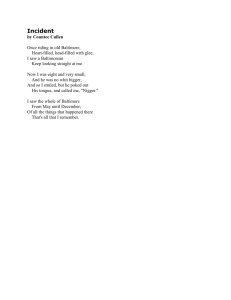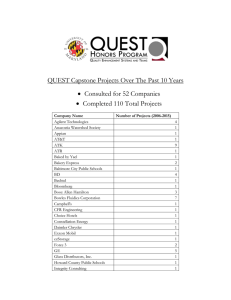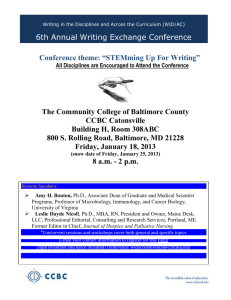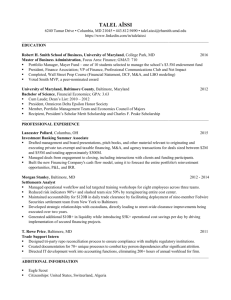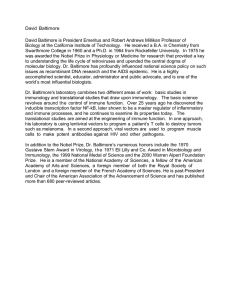PARTNER’S PERSPECTIVE: NNIP AND OPEN DATA IN BALTIMORE
advertisement
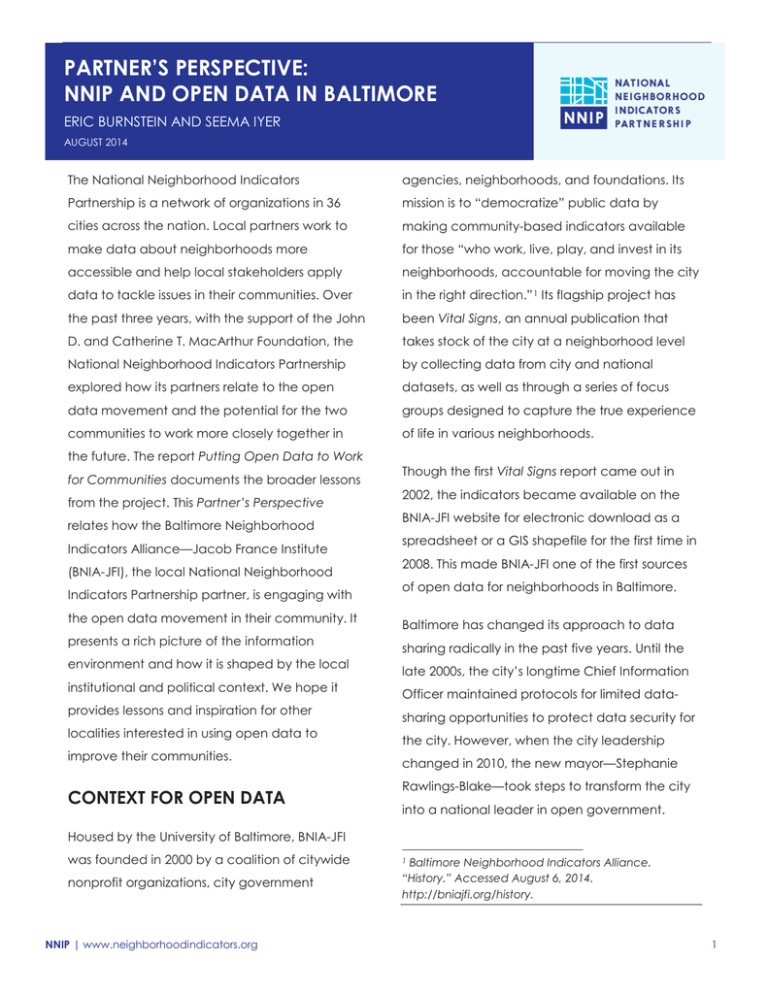
CASE STUDY: NNIP AND OPEN DATA IN BALTIMORE PARTNER’S PERSPECTIVE: NNIP AND OPEN DATA IN BALTIMORE ERIC BURNSTEIN AND SEEMA IYER AUGUST 2014 The National Neighborhood Indicators agencies, neighborhoods, and foundations. Its Partnership is a network of organizations in 36 mission is to “democratize” public data by cities across the nation. Local partners work to making community-based indicators available make data about neighborhoods more for those “who work, live, play, and invest in its accessible and help local stakeholders apply neighborhoods, accountable for moving the city data to tackle issues in their communities. Over in the right direction.” 1 Its flagship project has the past three years, with the support of the John been Vital Signs, an annual publication that D. and Catherine T. MacArthur Foundation, the takes stock of the city at a neighborhood level National Neighborhood Indicators Partnership by collecting data from city and national explored how its partners relate to the open datasets, as well as through a series of focus data movement and the potential for the two groups designed to capture the true experience communities to work more closely together in of life in various neighborhoods. the future. The report Putting Open Data to Work for Communities documents the broader lessons from the project. This Partner’s Perspective relates how the Baltimore Neighborhood Indicators Alliance—Jacob France Institute (BNIA-JFI), the local National Neighborhood Indicators Partnership partner, is engaging with the open data movement in their community. It presents a rich picture of the information environment and how it is shaped by the local institutional and political context. We hope it provides lessons and inspiration for other localities interested in using open data to improve their communities. CONTEXT FOR OPEN DATA Though the first Vital Signs report came out in 2002, the indicators became available on the BNIA-JFI website for electronic download as a spreadsheet or a GIS shapefile for the first time in 2008. This made BNIA-JFI one of the first sources of open data for neighborhoods in Baltimore. Baltimore has changed its approach to data sharing radically in the past five years. Until the late 2000s, the city’s longtime Chief Information Officer maintained protocols for limited datasharing opportunities to protect data security for the city. However, when the city leadership changed in 2010, the new mayor—Stephanie Rawlings-Blake—took steps to transform the city into a national leader in open government. Housed by the University of Baltimore, BNIA-JFI was founded in 2000 by a coalition of citywide nonprofit organizations, city government NNIP | www.neighborhoodindicators.org Baltimore Neighborhood Indicators Alliance. “History.” Accessed August 6, 2014. http://bniajfi.org/history. 1 1 PARTNER’S PERSPECTIVE: NNIP AND OPEN DATA IN BALTIMORE As part of her agenda, the city announced custom data that was provided in the past and plans for the Open Baltimore data portal, to is not available through the portal. “provide, to the public, access to City data in an effort that supports government transparency, openness and innovative uses that will help improve the lives of Baltimore residents, visitors and businesses through use of technology.” 2 The portal went live in its beta version in 2011, using the Socrata platform to share data and power online visualization tools. With open data in public discourse, the new question among city agencies and the city’s law department became “what is truly open, what isn’t, and what should and shouldn’t be [online].” The city focused on the process of cataloging city data and determining what could be released while still complying with privacy laws. In the meantime, the agencies did not update the data online, so users had to wait for two years until the city updates resumed. The city’s increased use of the open data portal has enabled BNIA-JFI to download datasets directly from the portal beginning in 2013. However, retrieving data online rather than collecting it directly from city agencies created unexpected challenges for BNIA-JFA’s Vital Signs. Staff turnover in Baltimore city agencies has meant that that new personnel often respond to BNIA data requests by directing them to Open Baltimore. BNIA-JFI still needs to commit staff time to negotiate with city agency staff for The city’s embrace of open data also included compromising on the availability of fine-grain data. BNIA-JFI previously received crime data directly from the police department, which included all calls for service, all juvenile request data, and actual locations of crime incidents. Starting in 2012, BNIA-JFI experienced significant delays in getting the data it needed from the police department because its primary connection left the department. On the Open Baltimore portal, BNIA-JFI can only get the “rounded address,” which gives the location down to the 100-unit block– complicating geocoding and assignment to a neighborhood for aggregation. Consequently, BNIA-JFI’s most recent release excluded many crime indicators for the first time since its inception. PROGRESS IN OPEN DATA BNIA-JFI’s current work reinforces its position as a key data intermediary in Baltimore and an organization that both uses open data as inputs and serves as a source of open data for community-based indicators. Users can select data on the BNIA-JFI website either by indicator or by community and then can export the results in more formats than were previously available, such as CSV or PDF files. BNIA-JFI is currently developing new ways to query their data online to make it entirely responsive to the needs of the See the welcome message on Open Baltimore. “Homepage.” Accessed August 6, 2014. https://data.baltimorecity.gov/. 2 NNIP | www.neighborhoodindicators.org individual user. BNIA-JFI, with limited staff, has also decided to focus internal efforts on 2 PARTNER’S PERSPECTIVE: NNIP AND OPEN DATA IN BALTIMORE providing high-quality data, rather than a more user-driven query tool for their website. In expanding their activities in data visualization. order to prepare for the event, BNIA-JFI had to Given the city’s promotion of the Open build its own capacity to serve as the data Baltimore portal and BNIA-JFI’s longstanding source by creating an account with GitHub (a relationship with the city’s Chief Data Officer, website for collaborating on and sharing code), Open Baltimore has a dedicated section to host getting data into a usable database format, Vital Signs, visualizing the data through the and defining a project with a clear civic purpose portal’s Socrata platform. In May 2014, BNIA-JFI relatable to the tech community. Though no released the 12th edition of Vital Signs, which publically available tool came out of this event, was posted on both its own website and Open it led the way for BNIA-JFI to effectively Baltimore. BNIA-JFI also has a strong connection participate in other Gb.tc hackathons, including with Maryland Institute College of Art’s the National Day of Civic Hacking. In June 2013, Information Visualization program, who “literally a team of civic hackers used BNIA-JFI data in the pick up where [they] leave off,” in terms of creation of baltimorevacants.org, an online making raw data communicable to the general mapping tool that pinpoints vacant buildings in public in engaging and accurate forms. the city, and links them to neighborhood-level “HACKING” WITH OPEN DATA demographic indicators. This team won the Sunlight Foundation’s Award for Transparency. The second purpose of Open Baltimore was to In July 2013, with the assistance of the Gb.tc, enable the local developer community to BNIA-JFI combined a hackathon with their develop applications that will help the city solve annual Baltimore Data Day workshop, which problems. The Greater Baltimore Tech Council brings together community organizations in the (Gb.tc) was created in 1999, but since 2012 it city to share ideas and data available to the has begun actively championing open data by public through a series of presentations and both promoting networking across the tech interactive sessions. BNIA-JFI also makes all community and building community through presentations from prior Data Days available on open-source programming events. Through a its website. This year, the fifth annual event was growing collaboration with the Gb.tc network, on July 25, 2014. BNIA-JFI was offered the opportunity to be a featured “local project” during the Grace Hopper Women in Computing conference, held in Baltimore in 2012. As part of this event, the Institute hosted a hackathon for attending women engineers from such companies as Google, and Facebook, it charged with creating NNIP | www.neighborhoodindicators.org FUTURE DIRECTIONS Gb.tc disbanded because of funding difficulties in February 2014. Its board reportedly has plans to restructure as part of Betamore, a local forprofit start-up accelerator, but the timing for 3 PARTNER’S PERSPECTIVE: NNIP AND OPEN DATA IN BALTIMORE reviving the organization is unclear. Without The other primary users of BNIA-JFI data are Gb.tc to organize the tech community, BNIA-JFI faculty and students from the many colleges may need to have a stronger voice in the city for and universities in the Baltimore region and open data. Though BNIA-JFI doesn’t engage in beyond. Students at all levels have accessed broad policy advocacy, it views advocating their data, either as part of their research, or open data as a key component to their own through community-based learning assignments. work, government operations, and informed BNIA-JFI has received funding to develop formal decisionmaking. curricula supports for use in the classroom that is While BNIA-JFI’s main mission continues to be improving data literacy in disadvantaged communities, the greater availability of open data has meant broader connections with the modeled after KIDSCount in the Classroom, an educational extension of the KIDSCount program funded by the Annie E. Casey Foundation. tech community (civic hackers) and local Overall, open data is a critical component of a entrepreneurs who recognize ways of monetizing positive and sustainable future for BNIA-JFI. When the value of open data. This may result in Vital Signs 12 was released in May 2014, the 2013 unforeseen competition for resources in order to version of the baltimorevacants.org website was remain a sustainable project in Baltimore. updated within a week of its posting, indicating Recently, a Baltimore consulting firm launched increasing interdependence within the Baltimore an online resource called Baltimore Datamind, open data ecosystem. An increasing number of which includes maps and visualizations using the people and organizations who want BNIA-JFI to Vital Signs data through an ESRI online platform. provide open data solidifies BNIA-JFI’s role in the The mapping website does acknowledge BNIA- broader conversation on data-driven JFI as the primary source of data, but not directly decisionmaking for neighborhoods. on the homepage. The unique value of BNIAJFI’s work in developing the neighborhood indicators may be less apparent to users when they access visualizations of the data through another source, such as Baltimore Datamind. However, BNIA-JFI staff strongly believe that the project does align with the core value of open data in its role in supporting new innovations. The experience has led BNIA-JFI to investigate establishing creative commons licensing when releasing data in the future. NNIP | www.neighborhoodindicators.org 4 PARTNER’S PERSPECTIVE: NNIP AND OPEN DATA IN BALTIMORE Eric Burnstein is a research associate in the Metropolitan Housing and Communities Center at the Urban Institute. Seema Iyer is an associate director and research assistant professor for the Jacob France Institute in the University of Baltimore’s Merrick School of Business, and has overseen the Baltimore Neighborhood Indicators Alliance (BNIA) since 2011. This paper was supported by the John D. and Catherine T. MacArthur Foundation. The views expressed are those of the authors and do not necessarily represent those of the MacArthur Foundation or the Urban Institute, its trustees, or its funders. Copyright © 2014. Urban Institute. Permission is granted for reproduction of this file, with attribution to the Urban Institute. NNIP | www.neighborhoodindicators.org 5
